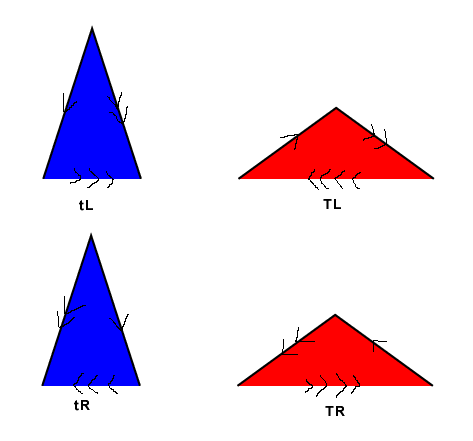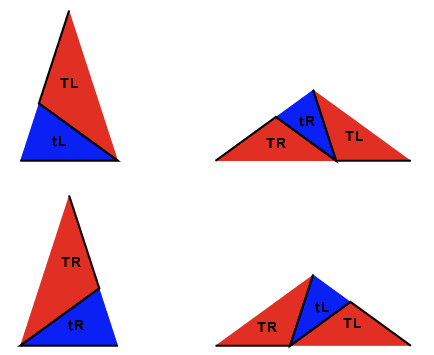| Line 7: | Line 7: | ||
The specific transformation is described as follows by Gardner: “Imagine that every dart is cut in half and then all short edges of the original pieces are glued together. The result: a new tiling... by larger darts and kites.” Deflation is the same process but in reverse. These operators do not maintain tile boundaries but do maintain half tiles. | The specific transformation is described as follows by Gardner: “Imagine that every dart is cut in half and then all short edges of the original pieces are glued together. The result: a new tiling... by larger darts and kites.” Deflation is the same process but in reverse. These operators do not maintain tile boundaries but do maintain half tiles. | ||
| − | A way to describe this process for the Penrose tiling that uses rhombi is by substituting triangles. Recall that this type of tiling is made up of two rhombi: a thick one and a thin one, each consisting of two isosceles triangles. The deflation process consists of breaking each of these triangles down into combinations of smaller versions of these triangles. See below: the left figure has the four different triangles that make up the rhombi shapes. The right picture shows each of the four triangles split into substitutions, consisting of smaller triangles arranged together (Schweber). | + | A way to describe this process for the Penrose tiling that uses rhombi is by substituting triangles. Recall that this type of tiling is made up of two rhombi: a thick one and a thin one, each consisting of two isosceles triangles. The deflation process consists of breaking each of these triangles down into combinations of smaller versions of these triangles. See below: the left figure has the four different triangles that make up the rhombi shapes. The right picture shows each of the four triangles split into substitutions, consisting of smaller triangles arranged together. |
| + | |||
| + | <center> | ||
| + | [[File:Rhombus triangles.gif|frame|Triangles that comprise the rhombi (Schweber)]] | ||
| + | </center> | ||
| + | |||
| + | A tiling can be deflated by performing these substitutions on each of the shapes. In fact, the starting figure does not even need to be a tiling. One could conceivably start with just one rhombus and perform these substitutions repeatedly on its two triangles until a tiling with the desired level of refinement is reached. Inflation is the same process but in reverse. When performing an inflation, one would look for patterns that match the smaller triangle substitutions seen above, and then replace this area with a single, larger triangle. The overall process looks like the one seen below; this shows several iterations of the substitution process, demonstrating how a single tile can be turned into a fairly intricate Penrose tilings after performing just seven rounds of substitutions (deflation would, of course, be this same process but in the opposite direction). | ||
| + | <center> | ||
| + | [[File:Triangles.png|frame|Triangle substitutions (Schweber)]] | ||
| + | </center> | ||
[[Walther_MA271_Fall2020_topic27|Penrose Tiling Home]] | [[Walther_MA271_Fall2020_topic27|Penrose Tiling Home]] | ||
Revision as of 20:42, 6 December 2020
INFLATION AND DEFLATION
An interesting facet of Penrose tilings is that there are infinitely many of them. This can be proven by examining a phenomenon, called inflation and deflation, that was discovered by Roger Penrose himself. Inflation essentially turns the tiling into a less complex version of itself; the size of the tiling stays constant but the prototiles themselves are larger pieces. Deflation does the opposite; it splits the tiles of the tiling into smaller shapes that form a different pattern that is more refined.
The specific transformation is described as follows by Gardner: “Imagine that every dart is cut in half and then all short edges of the original pieces are glued together. The result: a new tiling... by larger darts and kites.” Deflation is the same process but in reverse. These operators do not maintain tile boundaries but do maintain half tiles.
A way to describe this process for the Penrose tiling that uses rhombi is by substituting triangles. Recall that this type of tiling is made up of two rhombi: a thick one and a thin one, each consisting of two isosceles triangles. The deflation process consists of breaking each of these triangles down into combinations of smaller versions of these triangles. See below: the left figure has the four different triangles that make up the rhombi shapes. The right picture shows each of the four triangles split into substitutions, consisting of smaller triangles arranged together.
A tiling can be deflated by performing these substitutions on each of the shapes. In fact, the starting figure does not even need to be a tiling. One could conceivably start with just one rhombus and perform these substitutions repeatedly on its two triangles until a tiling with the desired level of refinement is reached. Inflation is the same process but in reverse. When performing an inflation, one would look for patterns that match the smaller triangle substitutions seen above, and then replace this area with a single, larger triangle. The overall process looks like the one seen below; this shows several iterations of the substitution process, demonstrating how a single tile can be turned into a fairly intricate Penrose tilings after performing just seven rounds of substitutions (deflation would, of course, be this same process but in the opposite direction).
Previous Section: Rules for Generating Penrose Tilings
_________________



